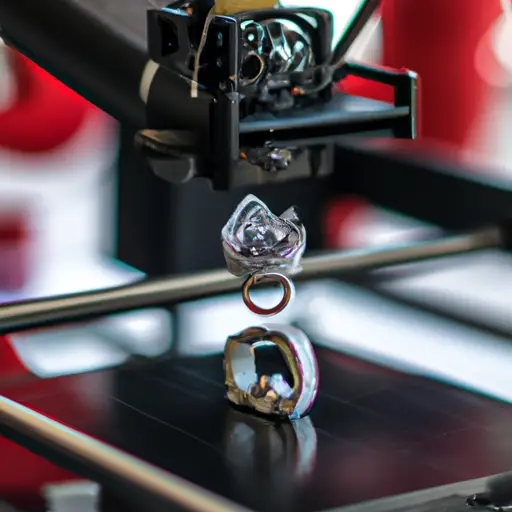In the vast landscape of the 3D printing industry, there lies a hidden treasure trove of untapped potential – the niche markets. Like a needle in a haystack, these specialized markets offer unique opportunities for innovation, profitability, and growth.
Exploring these uncharted territories requires a keen eye for identifying profitable niches, overcoming challenges, and implementing effective strategies. This article delves into the world of niche markets in 3D printing, sharing insights, success stories, and future trends that promise to shape the industry’s trajectory.
The Potential of Niche Markets in 3D Printing
The potential of niche markets in 3D printing is significant, as it offers unique opportunities for customization and innovation.
As the technology continues to advance, niche markets are emerging as a promising area for potential growth in the 3D printing industry. Niche markets refer to specific segments within the larger 3D printing market, focusing on specialized products or applications that cater to a specific customer base.
One of the main advantages of targeting niche markets is the reduced level of market competition. By focusing on specific customer needs, businesses can differentiate themselves from larger competitors and establish a strong market presence. This allows for greater control over pricing and product offerings, as well as the ability to provide customized solutions that meet the unique requirements of niche customers.
Furthermore, niche markets offer the potential for long-term growth and sustainability. As 3D printing technology advances, the ability to create highly customized products becomes increasingly feasible. This opens up opportunities for businesses to tap into niche markets that were previously inaccessible due to limitations in traditional manufacturing processes.
Identifying Profitable Niche Markets in the 3D Printing Industry
Profitable niche markets can be identified in the 3D printing industry through careful analysis of customer needs, market trends, and technological advancements.
By understanding these factors, businesses can overcome barriers and tap into niche markets that have the potential for significant growth.
One way to identify profitable niche markets is to analyze customer needs. This involves understanding the specific requirements and pain points of customers that can be addressed through 3D printing solutions. For example, industries such as healthcare, automotive, and aerospace have unique needs that can be met through customized and on-demand manufacturing enabled by 3D printing. By focusing on these specific customer needs, businesses can position themselves as experts in their niche and attract a loyal customer base.
Another factor to consider when identifying profitable niche markets is market trends. Keeping up with the latest developments in the 3D printing industry and understanding emerging markets can provide valuable insights into potential growth areas. For instance, the rise of additive manufacturing in the jewelry industry or the increasing demand for 3D printed prosthetics are examples of niche markets that have seen significant growth in recent years.
Technological advancements also play a crucial role in identifying profitable niche markets. Monitoring advancements in 3D printing materials, processes, and software can uncover new opportunities for niche market growth. For instance, the development of high-performance materials like carbon fiber composites or the ability to print complex geometries with multi-material capabilities opens up possibilities in industries such as architecture or consumer goods.
Overcoming Challenges in Serving Niche Markets With 3D Printing
Effectively serving niche markets with 3D printing presents its own unique set of challenges that businesses must navigate in order to capitalize on the opportunities within these specialized segments. One major challenge lies in customization. Niche markets often demand highly customized products that cater to specific needs and preferences. This requires businesses to have the capability to offer a wide range of customizable options, from materials to design features, and to ensure that the end product meets the exact specifications of the customer.
Another challenge is the fluctuating demand and supply within niche markets. Due to their specialized nature, niche markets may have limited customer bases, resulting in fluctuating and unpredictable demand. Businesses in this space must be able to adapt to these fluctuations by managing inventory effectively and optimizing production processes to meet changing demands.
To better understand the challenges in serving niche markets with 3D printing, let’s take a look at the following table:
| Challenges in Customization | Niche Market Demand and Supply |
|---|---|
| Limited resources | Fluctuating customer base |
| Complex design requirements | Unpredictable demand |
| Customizable options | Limited supply |
Success Stories: Niche Market Innovators in 3D Printing
Notably, several pioneering companies have emerged as trailblazers in the realm of niche market innovation in 3D printing, consistently pushing the boundaries of what is possible in this rapidly evolving industry. These success stories demonstrate the power of catering to specific customer needs and creating innovative niche products.
-
Shapeways: Shapeways is a leading 3D printing marketplace that allows users to create and sell their own designs. By providing a platform for designers to reach a global audience, Shapeways has revolutionized the way custom products are made and distributed.
-
Carbon: Carbon is a company that specializes in 3D printing using a technology called Digital Light Synthesis (DLS). Their innovative approach allows for the production of high-quality, end-use parts at a faster rate than traditional methods. This has made them a go-to choice for industries such as automotive and healthcare.
-
Formlabs: Formlabs has made a name for itself in the niche market of desktop 3D printers. Their user-friendly machines and high-quality prints have attracted a wide range of professionals and hobbyists alike, making them a popular choice for those looking to bring their ideas to life.
-
Organovo: Organovo focuses on bioprinting, a niche market within 3D printing that involves creating human tissue. Their innovative technology has the potential to revolutionize the medical field, with applications ranging from drug testing to organ transplantation.
These success stories highlight the immense potential and impact of niche market innovators in the 3D printing industry. By focusing on specific customer needs and creating innovative products, these companies have paved the way for further advancements in the field.
Strategies for Targeting Niche Markets in the 3D Printing Industry
When it comes to targeting niche markets in the 3D printing industry, one of the key strategies is identifying profitable niche markets. This involves conducting market research and analysis to understand the specific needs and demands of potential customers.
Once a profitable niche market is identified, effective marketing strategies can be developed to reach and engage with the target audience. These strategies may include targeted advertising campaigns, partnerships with industry influencers, and leveraging social media platforms to showcase unique capabilities and products.
Identifying Profitable Niche Markets
To successfully pinpoint profitable niche markets in the 3D printing industry, it is crucial to carefully analyze and assess the specific needs and demands of potential customers. This can be done through market analysis, which involves studying the current market trends, competition, and customer preferences. By understanding the challenges and opportunities present in the market, businesses can identify gaps and niche markets that can be targeted for profitability.
Here are four strategies for identifying profitable niche markets in the 3D printing industry:
- Conduct thorough market research to identify untapped customer segments.
- Analyze customer feedback and reviews to understand their pain points and unmet needs.
- Look for industries or sectors that could benefit from 3D printing technology and offer unique value propositions.
- Stay updated with emerging trends and technologies in the 3D printing industry to identify new niche markets.
Effective Marketing Strategies
An effective marketing strategy for targeting niche markets in the 3D printing industry is to leverage the power of social media and online advertising.
One way to do this is by creating customer personas for effective niche market targeting. Customer personas are fictional representations of your ideal customers, and they help you understand their needs, preferences, and behaviors. By creating detailed personas for each niche market segment, you can tailor your marketing messages and strategies to resonate with the specific needs and interests of each group.
Additionally, utilizing social media influencers for niche market promotion can be highly effective. Influencers have a dedicated following within specific niche markets, and partnering with them can help you reach your target audience in a more authentic and engaging way. By aligning your brand with influencers who have a strong presence in the 3D printing industry, you can leverage their credibility and reach to promote your products or services to the right niche markets.
Future Trends and Opportunities in Niche Markets for 3D Printing
Expanding into emerging markets and diversifying product offerings will drive growth and create new opportunities for niche markets in the field of 3D printing. As the technology continues to evolve, future applications and emerging technologies are expected to shape the landscape of niche markets in this industry.
Here are four key trends and opportunities to watch out for:
-
Healthcare: The healthcare sector presents a promising niche market for 3D printing. Personalized prosthetics, dental implants, and surgical models are just a few examples of the potential applications in this field. The ability to create custom-made medical devices with improved accuracy and functionality has the potential to revolutionize patient care.
-
Aerospace and Defense: The aerospace and defense industries have been early adopters of 3D printing technology. With the ability to produce complex, lightweight parts on-demand, this technology offers cost and time-saving advantages. As the demand for more advanced and customized aerospace components grows, niche markets in this sector will continue to expand.
-
Fashion and Accessories: 3D printing has also found its place in the world of fashion and accessories. From intricate jewelry pieces to avant-garde clothing designs, this technology provides designers with endless possibilities for customization and experimentation. Niche markets catering to fashion-forward consumers seeking unique and personalized items are expected to thrive.
-
Construction and Architecture: 3D printing in construction and architecture has the potential to revolutionize the way buildings are designed and constructed. The ability to fabricate complex structures on-site using sustainable materials can lead to cost-effective and environmentally friendly solutions. Niche markets focusing on architectural models, customized fixtures, and sustainable construction materials are poised for growth.
As the 3D printing industry continues to advance and explore new possibilities, niche markets will play a crucial role in driving innovation and meeting the specific demands of various industries. By embracing emerging technologies and identifying future applications, businesses can position themselves to seize the opportunities that lie ahead.
Frequently Asked Questions
Can You Provide a Step-By-Step Guide on How to Start a 3D Printing Business in a Specific Niche Market?
Starting a 3D printing business in a specific niche market requires a step-by-step approach. Begin by identifying target customers and their needs. Then, find the appropriate 3D printing technology and materials that suit the niche market.
How Can I Determine the Demand and Potential Profitability of a Niche Market in the 3D Printing Industry?
Determining demand and profitability in niche 3D printing markets requires a comprehensive assessment of market potential and analysis of profitability. By thoroughly examining market trends, competition, and target audience, one can uncover the potential for success in these specialized markets.
Are There Any Legal or Regulatory Challenges Specific to Serving Niche Markets With 3D Printing?
Legal challenges and regulatory obstacles can arise when serving niche markets with 3D printing. It is crucial to navigate intellectual property rights, safety regulations, and compliance standards to ensure legal compliance and mitigate potential risks.
Can You Share Some Examples of Companies That Have Successfully Tapped Into Niche Markets Using 3D Printing?
Some companies have successfully tapped into niche markets using 3D printing. These examples showcase the benefits of targeting specific customer segments, such as medical device manufacturers, aerospace companies, and customized jewelry designers.
What Marketing Strategies Can Be Effective in Targeting and Reaching Customers in Niche Markets for 3D Printing?
Innovative approaches to market research for niche markets in 3D printing involve identifying customer needs, preferences, and trends. Leveraging social media influencers can be effective for targeted marketing in niche 3D printing markets, reaching specific audiences with relevant content.
Conclusion
In conclusion, exploring niche markets in the 3D printing industry holds great potential for businesses looking to differentiate themselves and find profitable opportunities. By identifying and serving specific needs within these markets, companies can overcome challenges and achieve success.
The stories of niche market innovators in 3D printing demonstrate the effectiveness of this strategy. These companies have successfully identified a niche market and tailored their products or services to meet the unique needs of that market. As a result, they have been able to carve out a profitable space for themselves in the industry.
Going forward, strategies for targeting niche markets and future trends indicate that there are still numerous untapped opportunities for growth and innovation in the 3D printing industry. As technology continues to advance and new applications for 3D printing emerge, there will be even more potential for businesses to find their niche and thrive.
Overall, exploring niche markets in the 3D printing industry is a strategy that can lead to differentiation, profitability, and long-term success. By focusing on specific needs and tailoring products or services to meet those needs, businesses can position themselves as leaders in their chosen niche. With the right strategies and a keen understanding of market trends, companies can tap into the vast potential of the 3D printing industry and achieve sustainable growth.




